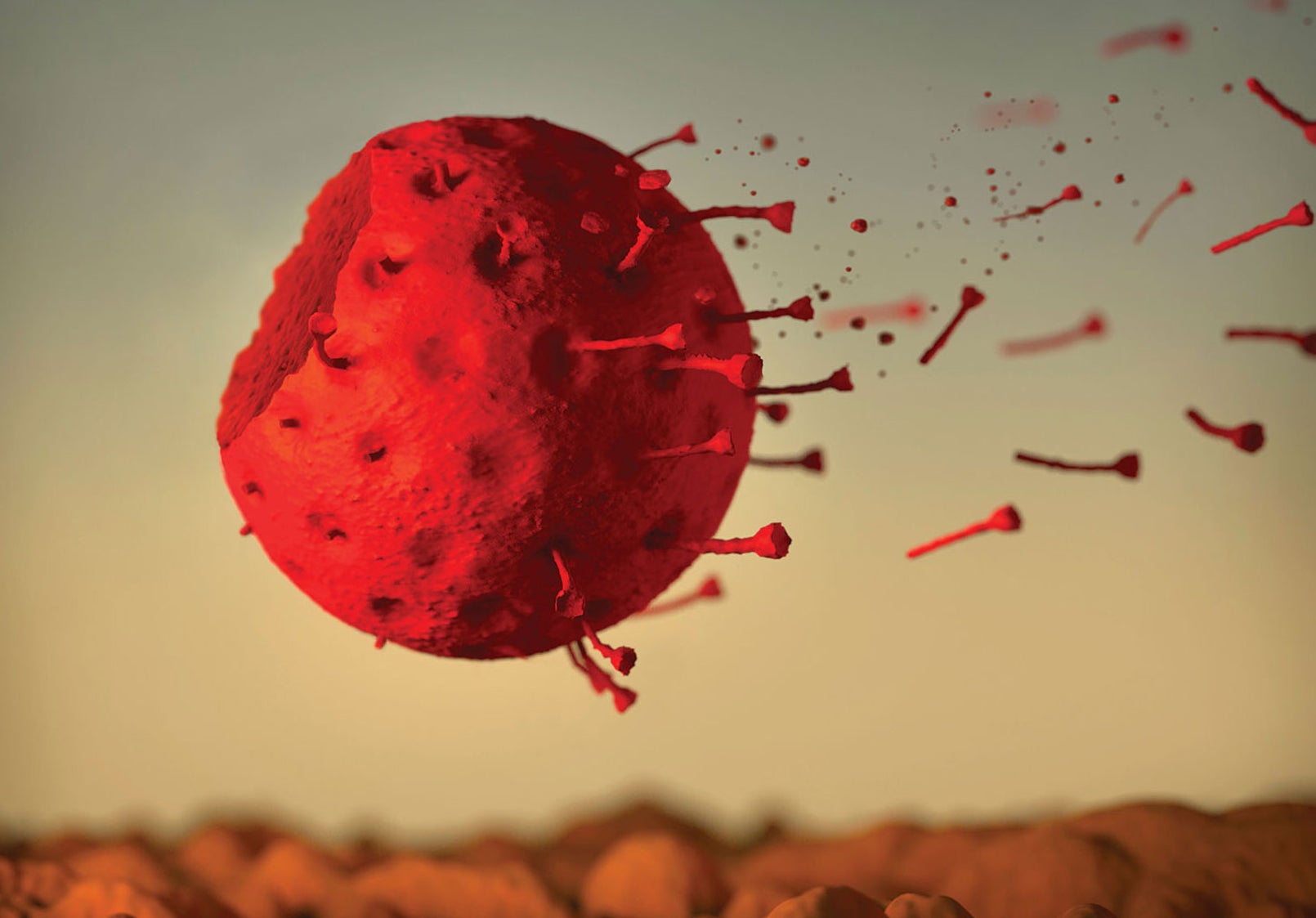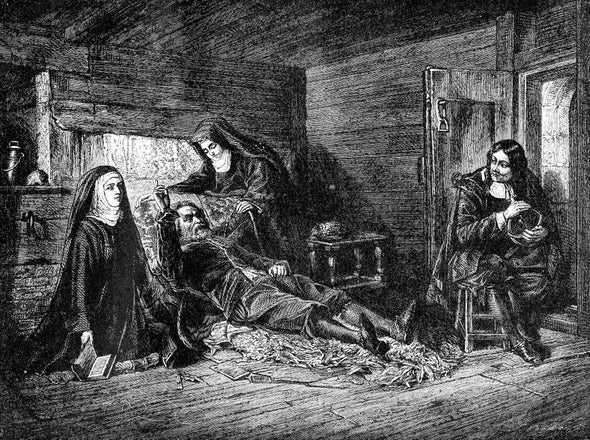How the COVID-19 Pandemic Could End Recent epidemics provide clues to ways the current crisis could stop .......... We know how the COVID-19 pandemic began: Bats near Wuhan, China, hold a mix of coronavirus strains, and sometime last fall one of the strains, opportunistic enough to cross species lines, left its host or hosts and ended up in a person. Then it was on the loose. ............ This coronavirus is unprecedented in the combination of its easy transmissibility, a range of symptoms going from none at all to deadly, and the extent that it has disrupted the world. A highly susceptible population led to near exponential growth in cases.
“This is a distinct and very new situation”
........... what happens next depends on both the evolution of the pathogen and of the human response to it, both biological and social.......... the H1N1 influenza outbreak of 1918–1919. Doctors and public health officials had far fewer weapons than they do today, and the effectiveness of control measures such as school closures depended on how early and decisively they were implemented.Over two years and three waves, the pandemic infected 500 million and killed between 50 million and 100 million.
It ended only as natural infections conferred immunity on those who recovered. .................. The H1N1 strain became endemic, an infectious disease that was constantly with us at less severe levels, circulating for another 40 years as a seasonal virus. It took another pandemic—H2N2 in 1957—to extinguish most of the 1918 strain. One flu virus kicked out another one, essentially, and scientists don’t really know how. ...........Of the seven known human coronaviruses, four circulate widely, causing up to a third of common colds.
........... Influenza viruses are slippery, mutating rapidly to escape immunity. As a result, the vaccines must be updated every year and given regularly. ............ Projections about how COVID-19 will play out are speculative, but the end game will most likely involve a mix of everything that checked past pandemics:Continued social-control measures to buy time, new antiviral medications to ease symptoms, and a vaccine.
.......... “The question of how the pandemic plays out is at least 50 percent social and political” .......... Researchers have banded together like never before ........... Compared with flu viruses, coronaviruses don’t have as many ways to interact with host cells. “If that interaction goes away, [the virus] can’t replicate anymore” ......... It is not clear whether a vaccine will confer long-term immunity as with measles or short-term immunity as with flu shots. But “any vaccine at all would be helpful at this point” ............ Unless a vaccine is administered to all of the world’s eight billion inhabitants who are not currently sick or recovered, COVID-19 is likely to become endemic. It will circulate and make people sick seasonally—sometimes very sick. ......... The combination of vaccination and natural immunity will protect many of us. The coronavirus, like most viruses, will live on—but not as a planetary plague.Galileo's Lessons for Living and Working Through a Plague An outbreak in Italy in the 1630s forced him to find new ways of doing his research and connecting with family ..............
Isaac Newton has repeatedly been held up as a model of epidemic-induced productivity, since he spent his 1666 “year of miracles” avoiding the plague in the English countryside and developing his ideas on gravity, optics and calculus.
.......... But isolation and quiet contemplation is only one model of science during plague times, and one to which few of us can really relate. ........... several of the most public and turbulent years of Galileo’s life took place during the great plague outbreak of 1630–33. .......... Galileo, who was born in 1564, had been a child in Florence during the previous major Italian outbreak of plague in 1575–77, which ravaged Northern Italy and killed 50,000 people in Venice—one third of the total population. .......... “Let me say first that when I decided to come here I did so out of desire to save my life, not for recreation or a change of air.” ........... “I want to live well… but he wants me to die healthy…. As long as I don’t die of plague, he’s happy to have me die of hunger.” .................. As we confront our own separation from loved ones, we should remember the ways in which Galileo’s devoted family supported him at a distance during this tumultuous period. ............ The challenges of articulating novel scientific discoveries that conflict with political and religious doctrine. The challenges of continuing an international scientific program over the course of nearly a decade of isolation and imprisonment. And, of course, the challenges of living in a time devastated by epidemic. ............ hold upGalileo as our exemplary plague scientist
. Bolstered by his relationships with his family and friends and strengthened by electuaries of dried fruit and honey, Galileo’s life teaches us that pursuing science has never been straightforward during an epidemic, and that it is nonetheless essential to persevere.Global coronavirus death toll could be 60% higher than reported Mortality statistics show 122,000 deaths in excess of normal levels across 14 countries analysed by the FT ....... Mortality statistics show 122,000 deaths in excess of normal levels across these locations, considerably higher than the 77,000 official Covid-19 deaths reported for the same places and time periods............ If the same level of under-reporting observed in these countries was happening worldwide, the global Covid-19 death toll would rise from the current official total of 201,000 to as high as 318,000.......... the daily counts in the UK, for instance, were “far too low” because they only accounted for hospital deaths. ........ This is especially worrying for many emerging economies, where total excess mortality is orders of magnitude higher than official coronavirus fatalities. .......... In Ecuador’s Guayas province, just 245 official Covid-related deaths were reported between March 1 and April 15, but data on total deaths show that about 10,200 more people died during this period than in a typical year — an increase of 350 per cent. ............ In the northern Italian region of Lombardy, the heart of Europe’s worst outbreak, there are more than 13,000 excess deaths in the official statistics for the nearly 1,700 municipalities for which data is available. This is an uptick of 155 per cent on the historical average and far higher than the 4,348 reported Covid deaths in the region. .........
In the Indonesian capital Jakarta, data on burials shows an increase of 1,400 relative to the historical average during the same period — 15 times the official figure of 90 Covid deaths for the same period.
...... Even the much higher numbers of deaths in the pandemic suggested by excess mortality statistics are likely to be conservative, as lockdowns mean that “mortality from numerous conditions such as traffic accidents and occupational injuries possibly went down” .........What if immunity to covid-19 doesn’t last? Researchers say people can catch mild, cold-causing coronaviruses twice in the same year. .......... four coronaviruses, HKU1, NL63, OC42, and C229E, which circulate widely every year but don’t get much attention because they only cause common colds. ........ a new coronavirus in the same broad family, SARS-CoV-2, has the world on lockdown .......... people frequently got reinfected with the same coronavirus, even in the same year, and sometimes more than once. Over a year and a half, a dozen of the volunteers tested positive two or three times for the same virus, in one case with just four weeks between positive results. .........
For the coronaviruses “immunity seems to wane quickly”
........ even though most people have previously developed antibodies to them, they get the viruses again ......... We’re currently in the pandemic phase. That’s when a new virus, which humans are entirely susceptible to, rockets around the planet. And humanity is still a greenfield for covid-19—as of April 26, there were about three million confirmed cases, or one in 2,500 people on the planet. (Even though the true number of infections is undoubtedly higher .........until a vaccine is available, the world should get ready for a “new way of living.”
...... “There are a lot of people who were infected and survived, and they are walking around, and they don’t seem to be getting reinfected or infecting other people” ..........if immunity is short, as it is for the common coronaviruses, covid-19 could set itself up as a seasonal superflu with a high fatality rate—one that emerges in a nasty wave winter after winter.
....... “Even though the common cold costs the US $20 billion a year, these viruses don’t kill, and anything that does not kill, we don’t have surveillance for.” ........... Is there a chance the disease will turn into a killer version of the common cold, constantly out there, infecting 10% or 20% of the population each year, but also continuing to kill one in a hundred? If so, it would amount to a plague capable of shaving the current rate of world population growth by a tenth. ............. “I don’t know when this goes away, and if anyone says they know, they don’t know what they are talking about”Coronavirus News (64) https://t.co/YVTjGMNipV #TrumpMeltdown #disinfectant #coronavirus #COVIDー19 #lockdown #pandemic
— Paramendra Kumar Bhagat (@paramendra) April 30, 2020




No comments:
Post a Comment